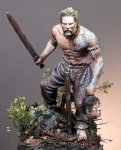AbdulAlhazred
Legend
They would have once and for all established culture as a flavor difference ie... removed both the potential glorification and degradation over flavor.... by maintaining the cultural difference is mostly flavor.
I do not think cultural appropriation is the term you are looking for (and that is kind of its own sort of nonsense for a different discussion altogether)
Heh, you and me both. Nobody owns culture, and one of the VERY few ways to earn my utter intellectual contempt is to utter the words 'cultural appropriation' in a context that suggests that someone else has more rights to express something simply because they happen to have been born with a certain skin tone or whatever, or in a certain place. I guess this verges on being a taboo subject, but few things in this world I've encountered are based on more ridiculous 'reasoning', lol.
So, I massively agree. There should be no classes that are strictly based on cultural flavor. They can be based on doing a particular shtick that is perhaps prevalent in one culture's depictions of some sort of legendary/mythical/fictional material, but the basis of the class should be the mechanical instantiation of that into the game world. It should be entirely possible for any fighter to do the same things as any other fighter, and maybe when the 'Samurai' whacks you hard with his sword he emits a great 'ki yai' and maybe when Buster to Viking does it he just screams a battle cry, but there's no reason for it to be mechanically a different thing. Likewise equipment. A katana or odachi are just swords, not really materially much different from an arming sword or a bastard sword wielded by a character equipped in a Western European inspired setting. You may get one or the other when you plonk down your 15gp depending on the setting, but its just color really.
Now, the Monk is an interesting case. While you could argue that a character could be based on an assassin or whatever and evince the same capabilities in a western setting its undoubtedly true that such characters really don't exist in western culture before modern times. Nor do they ENTIRELY fight into the mold of characters that in western fiction are 'Martial'. I think its very reasonable to equate Ki and Martial (having done so several times here) but lets imagine some character like Li Mu Bai. Can you call this character Martial? He does a number of things that are not usually considered martial, and are rather divine really. It does seem like that's a bit different from say Sir Launcelot, who is pretty thoroughly a sword-swinger. I think it can work as long as you don't take power source too strictly, but that is perhaps my ultimate ending point, power source is there to keep designers thematically focused, not to nail everything down into tight little boxes. Li Mu Bai is martial, just a bit different. A western character of the same class could exist, though its hard to see exactly how you'd flavor him.


